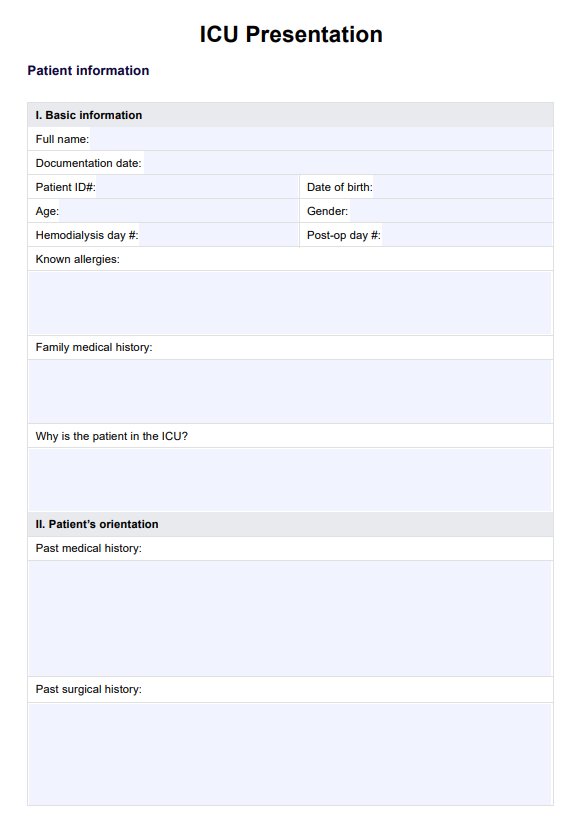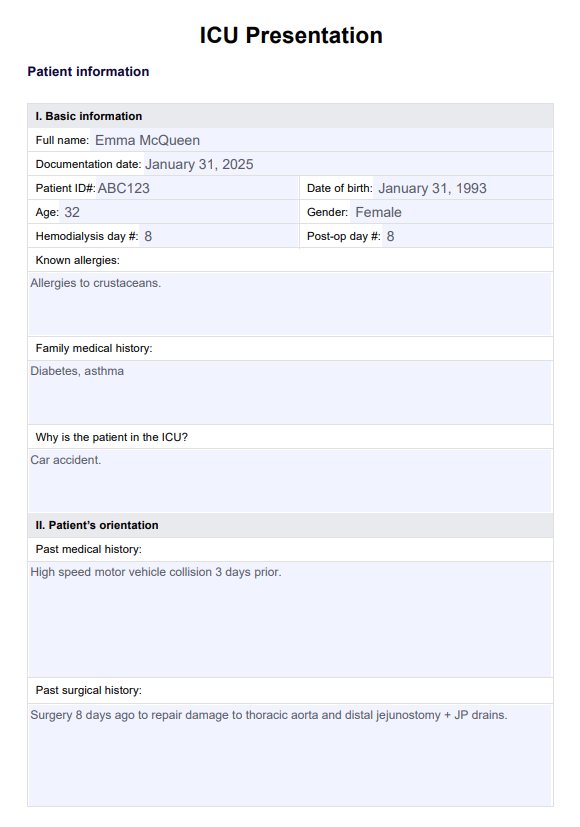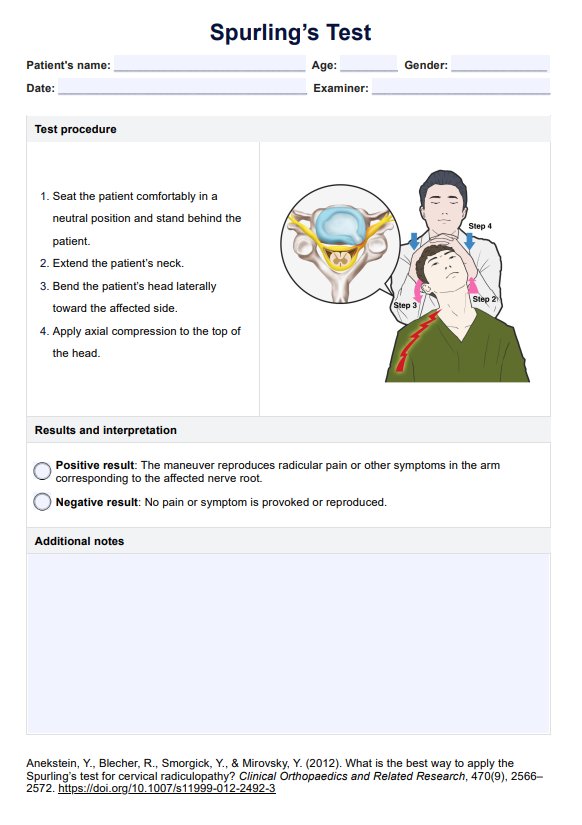ICU Presentation
Standardize your ICU patient presentations, and ensure you present all pertinent information with our structured ICU Presentation Template.


What is an ICU Presentation template?
Rounding is typically done daily in an intensive care unit (ICU), and involves various members of the patient's care team, including consultant doctors, specialists, junior doctors, nurses, and students. The practice of rounding is undertaken to get all team members up-to-speed on the patient's condition (these are usually critically ill patients) and any significant events that have occurred over the past 24 hours since the previous day's rounds.
Rounding also enables the patient's care team to make informed, collaborative decisions about the best next steps for the patient and coordinate the patient's care across multiple departments, especially if there were any overnight events worth noting.
As such, presenting ICU patients concisely, accurately, and thoroughly during ICU rounds is an important skill to develop as a doctor, nurse, or other health professional involved in ICU rounding.
Presenting patients succinctly and accurately is a crucial skill that junior doctors must develop during the early years of their training, and following a structured template like the one provided here is a great way to practice.
This ICU Presentation Template provides a comprehensive and structured approach to presenting patients and introduces many terms that will become familiar in the ICU.
ICU Presentation Template
ICU Presentation Example
How does it work?
This printable ICU Presentation template is a valuable tool, but using it correctly and with discretion is important to give the best patient presentations. To get the most out of this resource, just follow the steps below:
Step 1: Assess a patient's orientation
Provide a concise overview of the patient's background, including age, gender, and relevant social factors, days in hospital, and days since surgery. Summarize their medical history, emphasizing chronic conditions and previous surgeries. Clearly articulate the reason for ICU admission, outlining the primary diagnosis, complications, and the timeline of events.
Present the patient's current clinical status based on physical exam findings, highlighting vital signs and any changes since the last presentation. Finally, add a brief statement of your own interpretation of the patient's current status (i.e. stable, improving, declining, etc.).
Step 2: Conduct a systems review
Systematically review the relevant physiological systems. Discuss cardiovascular status, including heart rate and blood pressure. Address respiratory health, detailing ventilator settings and oxygenation. If applicable, touch on gastrointestinal function, renal function, neurological status, nutritional support, risk reduction, or hematology.
The template's structure allows you to move from one physiological or organ system to another without missing any bases.
Step 3: Add actionable items to your to-do list
Once your team has decided on the plan for your patient, add actionable items to the to-do list. These might include consultations with specialists, collaborations with other healthcare professionals, and ongoing discharge planning. You can add objectives like "enroll the patient in an occupational therapy program," "ensure maintenance of mechanical ventilation," or "conduct a spontaneous breathing trial every now and then."
Encourage interactive discussions, considering patient preferences, values, and goals in the decision-making process.
When would you use this template?
This template will be most useful on ICU rounds for physicians or nurses building their confidence in presenting patients to the team. As such, it can be used daily during rounds as a presentation tool.
This template can also be a note-taking tool for planning your patient presentation, even if you don't choose to use the presented structure.
This template can be used by students or those observing the ICU rounding process to practice distilling key information and familiarize themselves with the patient presentation process before they actually have to present.
The structured format of this ICU Presentation Template will prove invaluable during the systematic review of physiological systems. This step ensures a thorough examination of the cardiovascular, respiratory, renal, neurological, and other relevant systems, providing a holistic view of the patient's health.
Specific health practitioners who may especially benefit from having this template in their toolbox include:
- Physicians and resident doctors
- Junior doctors and medical trainees
- Medical and nursing students
- Nurses and nurse practitioners
- Allied health professionals
Benefits of this ICU Presentation template
So, why use our template? Here's a few reasons:
It helps professionals focus on pertinent information
One key function of this template is to allow you to focus on important results by filling in the relevant sections. This allows you to condense your ICU presentations, ensuring that important information is not lost in a stream of irrelevant data and normal results.
It can help cover key results
We have provided examples of the sorts of laboratory and diagnostic test results that might be relevant for each system review in the ICU. These allow you to gain familiarity with typical tests conducted and the many acronyms associated with each.
It's a pre-formatted template
Structuring your patient presentation clearly ensures seamless communication and reduces confusion among your team members. This template is pre-formatted with subjective information, objective information, and plan sections for each body system- allowing you to save time formatting and focus on the key results.
It can be used digitally or printed
Whether you like to work digitally or prefer pen and paper, this template can help. Use the fillable PDF template, or print it out and fill it in by hand if you prefer.
It can help structure your presentation
The template not only organizes your information but is also formatted in the order you would typically present it—with key patient information at the beginning to orient your team to the patient's condition, followed by more detailed system reviews.
Apart from all these reasons, you get all the free features that the Carepatron app has to offer: automated appointment reminders, hassle-free scheduling with clients, and HIPAA-compliant security. Just click "Use template" and register for a free account to head straight into using this template.
Commonly asked questions
The systems presented in this ICU presentation template represent an exhaustive list based on the template produced by the University of Florida. As such, not every system will necessarily be covered in ICU presentations. Systems should only be reviewed if relevant updates or events are to be shared with the rest of the patient’s care team.
This may vary from hospital to hospital, but typically, patients are presented by junior doctors (physicians), nurses, or more senior medical or nursing students.
No! This template is packed with ideas of what might be relevant to present, but everything should not be presented—unless you want to talk for a very long time. For the sake of brevity, it’s important to prioritize which results to present and which are normal and don’t need to be focused on during rounding.
















































































































